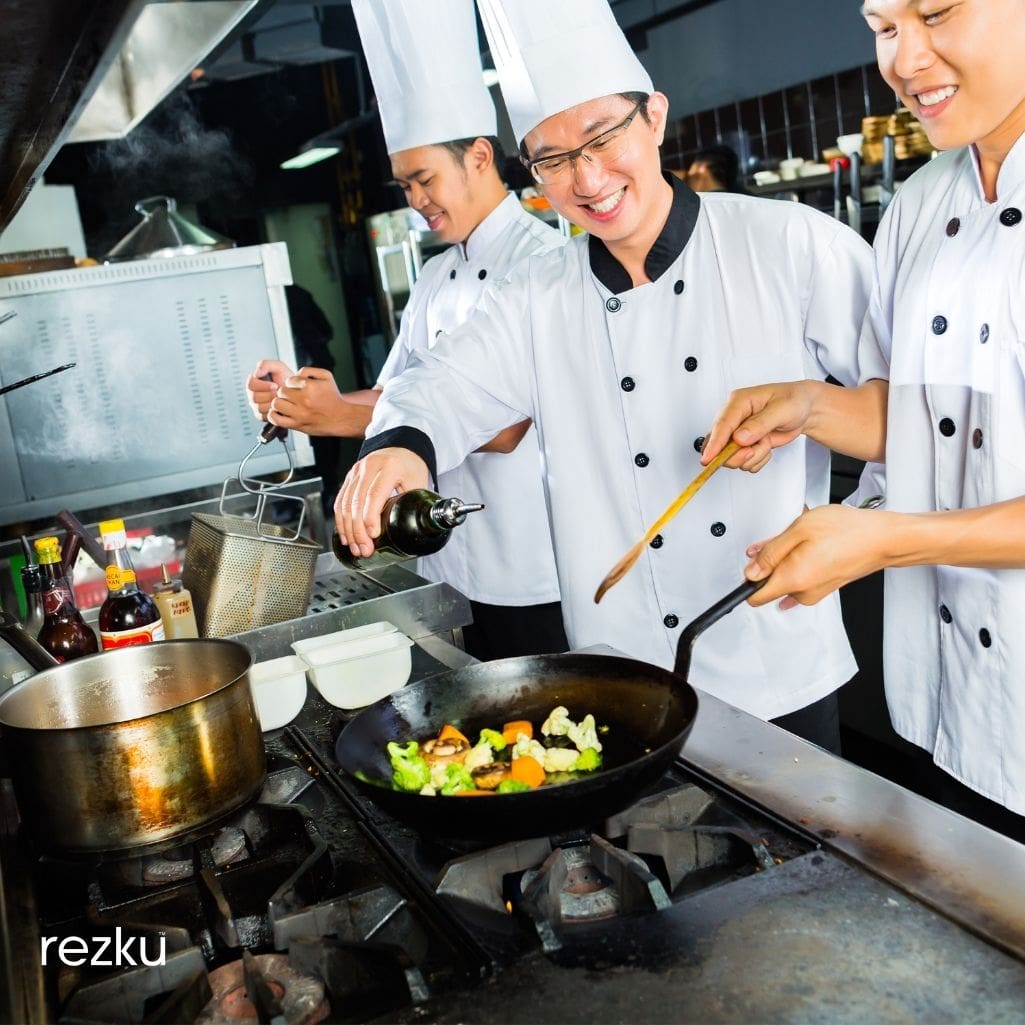Run Your Kitchen Like Clockwork: The Essential Strategies Of Effective Restaurant Kitchen Management The Pros Use
The Rezku Team

For any restaurant to achieve success, efficient and well-run kitchen operations are absolutely essential. The kitchen is the heartbeat of the business, responsible for executing the menu, controlling food costs, and ensuring superior quality and consistency for guests. Effective kitchen management requires a multi-faceted approach that covers everything from staff leadership to inventory practices to stringent quality control.
By focusing on several key areas, kitchen managers can optimize their back-of-house operations, get the most out of their crew, and set their restaurant up for consistent excellence.
Here are the essential strategies for taking your kitchen management game to the next level:
Staff Management
-
Having the right team in place is the foundation for a smooth-running kitchen. Work on recruiting experienced line cooks and chefs who have a passion for their craft. During interviews, assess their skills, creativity, ability to work under pressure, and culture fit.
-
Once you’ve assembled your brigade, provide comprehensive training to get everyone up to speed on kitchen procedures, food safety regulations, your recipes and standards for preparation and plating, and any technology or equipment they’ll be using. Spending sufficient time upfront on training pays major dividends down the road.
-
Beyond the technical skills, focus on building an environment of teamwork, open communication, and collaborative problem-solving. Clearly define each role’s responsibilities while encouraging cross-training so your team stays flexible. Make it a practice to regularly evaluate performance, provide constructive feedback, and identify opportunities for further training and professional growth.
Inventory and Ordering
-
Keeping your kitchen properly stocked is instrumental for minimizing delays, staying in control of food costs, and avoiding frustrating shortages. Implement a robust inventory management system that allows you to track stock levels, monitor usage rates, and analyze food costs down to the ingredient level. Leverage technology like a specialized inventory software integrating with your POS system.
-
Streamline your stock ordering processes by establishing par levels for each item and setting reorder points so you can automate ordering with your suppliers. Build relationships with a few reliable purveyors you can count on for high quality and consistent deliveries. Audit incoming orders against invoices to ensure you’re being charged correctly.
-
Minimizing food waste is not only cost-effective but also better for the environment. Implement strict procedures around properly labeling, dating, rotating, and storing all ingredients. Creatively repurpose any excess items into new dishes, staff meals, or specials to avoid spoilage. Conducting regular inventories keeps you aware of any loss or theft issues.
Kitchen Organization and Efficiency
-
An organized, efficient kitchen layout and corresponding systems and procedures are critical for a smooth service. Analyze your current setup and workflow to identify any bottlenecks or redundancies in the movement of food, personnel, and equipment. Rearrange stations and utilities as needed to optimize the flow from receiving to prep to cooking line to plating.
-
Standardize practices around mise en place, recipes, prep lists, plating guides, and firing orders to create consistency. Develop cleaning schedules and sanitation protocols that all staff adhere to in order to maintain a clean, organized, and safe working environment fully compliant with health codes. Assign specific cleaning duties and leverage good habits to keep clutter under control.
-
During service, establish clear protocols and responsibilities around expediting, calling out orders, plating, and garnishing. Implement labeling conventions, checklists and other visual cues to reduce errors. Use technology like Rezku’s Smart KDS that is designed to enhance communication flow. Continuously analyze and improve processes to boost efficiency wherever possible.
Equipment and Maintenance
-
Having the right commercial equipment is critical for executing your menu at full capacity while maintaining quality standards. Audit your current equipment and assess any additional needs based on your kitchen’s size, menu, and revenue. Budget accordingly for any major equipment investments that may be required.
-
Preventative maintenance is pivotal for maximizing equipment lifespan and avoiding frustrating breakdowns and service disruptions. Develop equipment cleaning and maintenance checklists with clear procedures and schedules for proper care. Ensure all components are cleaned, delimed, descaled, filters changed, and parts are lubricated at regular intervals based on the manufacturer’s recommendations. Address any repair issues promptly before they become larger problems.
-
Don’t overlook the importance of auditing the training your staff on the proper usage protocols for each piece of equipment. Don’t just focusing on food preparations but on cleaning, reassembly, safety procedures, and troubleshooting common issues. This investment in training helps prevent on the job injuries and costly equipment repair situations down the road.
Quality Control and Consistency
-
Developing standards and systems for ensuring superior food quality and consistency should be one of your top priorities as a kitchen manager. Start by documenting recipes with precise measurements, techniques, plating specs, and quality criteria so every dish meets your standards, regardless of who’s on the line.
-
Conduct routine tastings where your chefs and cooks can provide feedback on dishes and you can evaluate adherence to recipes, presentation, flavors, and textures. Have a protocol for addressing any variances and continuously updating recipes and standards as needed based on these tasting sessions.
-
Maintaining stringent food safety practices is also paramount, as you are legally required to avoid serious health code violations. Establish clear procedures and periodic monitoring to ensure safe food handling and prevention of cross-contamination. Spot-check for proper cooking and cooling temperatures, storage conditions, cleaning processes, and more. Have systems in place for tracking pull dates to ensure expired food is never served to guests.
Empower your staff to provide feedback on any issues and be open to making improvements to dishes or processes. True quality is an ongoing journey, not a final destination!
Kitchen-Front of House Communication
-
A cohesive relationship and efficient communication between the kitchen and front-of-house teams is vital for excellent service execution. Work closely with the front-of-house manager to develop systems and protocols around how food orders flow from the dining room to the kitchen. Establish clear procedures for how to communicate notes, firing orders, periods of high volume, 86’ed items, and any other crucial details to servers.
-
Implement appropriate technology solutions like a modern POS system with tableside ordering and a kitchen display system (KDS) that works seamlessly with traditional printers. This streamlines the flow of information from front of house to back of house, reducing errors and keeping servers out of the kitchen.
-
Don’t let animosity between servers and kitchen staff to build. Encourage cross-training where front and back of house staff spend time learning about each other’s roles and developing empathy for the differing challenges each team faces. Hold regular meetings that bring both teams together to discuss issues, gather feedback, plan for systems improvements, and reinforce the symbiotic relationship that’s required for success.
Conclusion
By optimizing these key areas of your kitchen operations, you’ll be well on your way to building an efficient, high-performing back-of-house engine that delivers excellent quality and consistent experiences for your guests. Effective kitchen management requires diligence, strong leadership, empowered staff, and a relentless focus on continuous improvement of your processes.
Rezku is an advanced point of sale system specifically designed for restaurants and is used in some of the most demanding food and beverage service environments in America. Rezku’s tablet-based technology seamlessly coordinates restaurant operations from ordering, through production and fulfillment for smooth performance and exceptional guest service.
Contact us today for a complimentary consultation.
Phone: 844-697-3958 x2
eMail: Sales@Rezku.com
Is Rezku the POS system you’ve been searching for?
Get a custom quote and start your free trial today.
Related Posts


